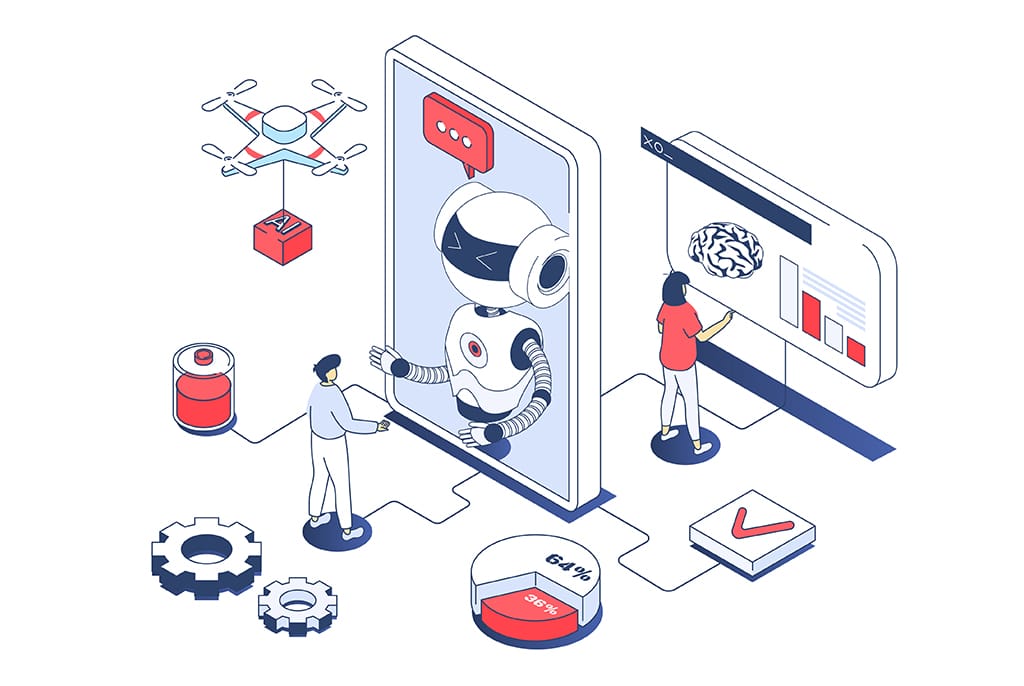AI best practices: 3 CEOs share how they are using emerging technologies

In the dynamic landscape of business technology, CEOs’ perspectives on artificial intelligence adoption are undergoing a significant shift. According to this year’s quarterly Vistage CEO Confidence Index surveys, the evolving sentiments of business leaders reveal a nuanced picture.
The Q2 Confidence Index survey in June disclosed that 33% of CEOs said their organizations were not actively using or testing AI, while 43% were either currently using or testing it.
The latest Q3 survey showcased that 30% of CEOs reported no plans to alter their budgets to incorporate AI capabilities. On the flip side, a diverse set of responses emerged from those actively budgeting for AI. A significant 65% of CEOs positioned themselves as early adopters of AI. Among them, 35% plan to either increase spending with existing vendors or allocate funds to new vendors.
Regardless of where you may fall on the spectrum, it is important to understand how AI can impact small and midsize businesses. We spoke with 3 Vistage members who have found success leveraging this technology, capturing their advice to help guide your own efforts.
Key takeaways from members in this session:
Dr. Shree Mulay, CEO of The Kidney Experts, PLLC
 Dr. Shree Mulay is a kidney doctor and the CEO of The Kidney Experts in western Tennessee. Driven by a mission to eliminate the necessity for dialysis worldwide, Dr. Mulay has seamlessly integrated AI into his company’s practices.
Dr. Shree Mulay is a kidney doctor and the CEO of The Kidney Experts in western Tennessee. Driven by a mission to eliminate the necessity for dialysis worldwide, Dr. Mulay has seamlessly integrated AI into his company’s practices.
- He uses AI mostly as a communication tool for responding to reviews, patient communications and website copywriting. He has also used it to summarize large documents and research papers.
- Benefits seen from implementing AI include streamlining communication, improving the readability of content and increasing the volume of what he can respond to at a faster speed.
- His whole team has access to AI tools, and he is creating an AI team within the company to help everyone get on board.
Shree acknowledges the need for further exploration of AI’s potential within his company, underlining the transformative impact AI will have. “There is no reason to not use AI in communication,” he says. “If you aren’t using AI today, you are already behind the curve.”
Dr. Stacey Schultz, President of Educate LLC
 Dr. Stacey Schultz is the President of Educate LLC, an education-coaching and learning organization based in New York. Their initial step involved fostering a culture of curiosity and exploration. Encouraging everyone to engage with AI, they offered a list of potential starting points while empowering the team to explore on their own. Subsequently, a comprehensive survey was deployed to capture insights from team members, which became the foundation for defining Educate’s overarching goals, mission, and ethical guidelines surrounding AI.
Dr. Stacey Schultz is the President of Educate LLC, an education-coaching and learning organization based in New York. Their initial step involved fostering a culture of curiosity and exploration. Encouraging everyone to engage with AI, they offered a list of potential starting points while empowering the team to explore on their own. Subsequently, a comprehensive survey was deployed to capture insights from team members, which became the foundation for defining Educate’s overarching goals, mission, and ethical guidelines surrounding AI.
At the heart of their AI initiatives is an ethics guide created internally, emphasizing three key principles:
- Transparency: Be open about when and how you are using AI. Source AI when you use it for external publishing (APA/Chicago/MLA has guidelines for how to cite ChatGPT).
- Equity: Remember that AI is built by people and therefore has biases. How can you overcome these biases? What critical lens can you put on when you are utilizing AI? Be critical of the output and never accept the initial output as the best and more correct.
- The human component: Determine how can you partner with AI, rather than replace a human with it. Focus on your social skills, leadership development and the humanity piece that AI can’t replace.
Justin Seibert, Founder and President of Direct Online Marketing
 Justin Seibert is the founder and President of Direct Online Marketing, which was founded 17 years ago and works to draw quality people to customers’ websites and convert that traffic into leads and sales. Integrating AI and automation has significantly saved his company time on routine tasks, allowing his team to work on more creative and impactful tasks to drive their clients’ success.
Justin Seibert is the founder and President of Direct Online Marketing, which was founded 17 years ago and works to draw quality people to customers’ websites and convert that traffic into leads and sales. Integrating AI and automation has significantly saved his company time on routine tasks, allowing his team to work on more creative and impactful tasks to drive their clients’ success.
Justin shared some of the early learnings his team has made regarding implementing AI:
- While creating an AI committee was great for news sharing and brainstorming, it may not be effective for actually implementing efforts.
- Understand what infrastructure needs to be put into place to implement AI. Don’t be too focused on the creative side of things and lose sight of practical implementation.
- Clearly define the purpose and end function of what you trying to create (i.e. content creation), without that clarity there are missed expectations.
- Things are always changing and new tools are constantly coming out, stay on top of changes.
- Putting things on the cloud for the whole team to use might create some unanticipated challenges. Develop an understanding of the resources and skill sets needed to accelerate results.
Each expert weighed in on attendee questions in the Q&A session, recapped below:
1. What are some of the tools you have utilized for ghost prompting/prompt engineering, and how did you go about building that skill among everyone involved in using them?
Justin: We centralized AI in the beginning with best practices, how-tos and 15 tones of voices we built out as prompts to feed into AI. We also hosted lunch-and-learn sessions to help employees understand how to get started. We created a prompt library to house documents filled with prompt chains that do things like help build personas and a voice to feed into AI to be more effective and customizable for what our employees are doing. We primarily use AI tools to bolster our prompt chains. The best example of this is using Perplexity, an AI search engine, to source initial research and background that can then be better utilized in prompts built for GPT-4.
Shree: I use Helloscribe, which is not Chat GPT-based and has 30-40 built-in prompts that you can rephrase to your liking. You can also add the type of tone for how you want the output to sound. Ghostwrite is used for my emails and has been very helpful, you can tell it if you want to write a casual or professional response. Sometimes I will refresh the output until I get the answer I want, or I will reword the original prompt I wrote to provide more details to get a more specific answer.
Stacey: JasperAI does learn your tone over time if you are looking for a trainable model. A few people in my team took an engineering prompt course and shared best practices from what they learned. We also practice live prompting in meetings and have utilized pre-published prompts from online. We find providing more info is better (creating that scenario aspect) and different punctuation helps! It also helps to be specific about what you want to get out of the tool, and a lot of platforms now also provide you with prompt ideas which is a great place to start.
2. Stacey, can you talk more about the closed language model that you are using to train AI?
Stacey: We’re collaborating with a development company to offer access to their advanced text-generation AI model. They provide four membership options granting varying levels of access, purchased through a token system. Interestingly, this partnership allows you to exert significant control over the AI’s input sources. Whether it’s specifying data sets for internal models like McKinsey reports or dictating external sources like Chat GPT and BARD, you can guide the text generation process. Additionally, you can request transparency by asking the model to reveal its information sources for any generated text. This collaboration thus presents a unique opportunity to tailor these powerful AI models to your specific needs and preferences.
3. Stacey, for members considering using a third party: What was your evaluation process for deciding to build your own AI tool and selecting someone to help build it for you?
Stacey: One of the things we are evaluating is how we cut down on people-heavy expenses. We have a people-first philosophy so we were looking for tools that match that. Is there something that can help support us in integrating into our product and services in a meaningful way, but can also help us save as we grow and scale by adding people at the end for the one-to-one work? How are you building your language model? What are some of the things you use and consider? For example, Rocky AI uses positive psychology prompting which aligns with our transformational coaching method.
4. Justin, what have you learned about what Google thinks of AI content? How are you managing to make sure you are truly optimizing your clients content?
Justin: Google is changing its guidelines over time and wants its users to continue to use their services. Their biggest fear is they will produce bad results that people won’t like and will trust google less when that happens. Google wants to make sure that the information is accurate, seems reliable and provides value based on what the person searches. AI can help you with all of those things when done well, but when done poorly, it’s gonna hurt the user experience. Google tracks if someone leaves your website immediately and will dock your rating on Google search if it sees your information as untrustworthy.
5. Stacey, at Educate what is your process for dealing with plagiarized content?
Stacey: We are trying to push the thinking. Instead of just evaluating if an assignment is plagiarized, instead, we ask “If it can be written by AI, is there a more critical way to create that assignment or partner with it? Embrace it a little and encourage students to partner with AI and share how they are pushing the thinking of what AI has produced for them and adding their personal touch.
Justin: If I could add on to that because what Stacey said resonated with me from a hiring perspective. We have a knowledge assessment as part of our hiring process, and we began to notice that when we would run it through a plagiarism checker, a lot of it was copied, which sparked a lot of internal discussion. We knew candidates might be working with AI, so we had to decide what are we measuring here. We are doing things a bit differently now where for some sections of the application we ask that candidates don’t use AI because we are trying to understand who they are. However, in other sections of the application, we may encourage candidates to feel free to use AI if they wish. We then use our Zoom or in-person interviews to dive in with somebody live to try to answer what we were trying to get on paper before.
6. Looking towards 2024 and strategic planning: What is important to include for next year’s technology budget?
Shree: Using AI has been cheap so far, I don’t feel a budget change is needed.
Justin: Using AI has been inexpensive (even if you are using ChatGPT 4 vs ChatGPT) and will continue to get less expensive and become fragmented very quickly. Rather than adjusting my technology budget, I would focus on the planning process because that is critical: do you want a dedicated AI person? Do you want an AI committee? Spend the time thinking through what makes sense for your organization.
These interviews have been condensed and edited for clarity.
Related Resources
AI roundtable: Best practices from small businesses [Webinar on-demand]

